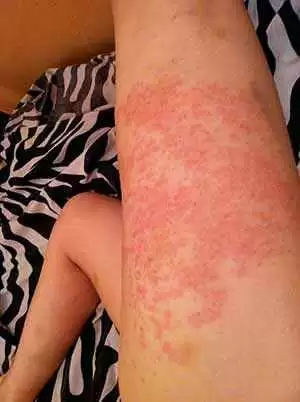The the connection between iodine and Dermatitis Herpetiformis is briefly described by the following excerpt from a resource guide of the Gluten Intolerance Group of North America:
- Iodine can trigger eruptions in some people (with dermatitis herpetiformis). However, iodine is a essential nutrient and should not be removed from the diet without a physicians supervision.
- Iodine does not contain gluten. Iodine can worsen the symptoms of skin lesions in patients with dermatitis herpetiformis.
- When the deposits of IgA have been cleared from the skin over time by following a gluten free diet, iodine should no longer present any problem for dermatitis herpetiformis patients.
As background, for those who are not familiar with Dermatitis Herpetiformis, the following description comes from a resource guide of the Gluten Intolerance Group of North America:
- Dermatitis herpetiformis (dermatitis herpetiformis) is a chronic disease of the skin marked by groups of watery, itch blisters. The ingestion of gluten (the proteins gliadin and prolamines contained in wheat, rye, oats, and barley) triggers an immune system response that deposits a substance, IgA (immonuglobin A), under the top layer of skin. IgA is present in affected as well as unaffected skin. dermatitis herpetiformis is a hereditary autoimmune disease linked with celiac disease. If you have dermatitis herpetiformis, you always have celiac disease. With dermatitis herpetiformis the primary lesion is on the skin rather than the small intestine. The degree of damage to the small intestine is often less severe or more patchy then those with only celiac disease. Both diseases are permanent and symptoms/ damage will occur after comsuming gluten.
Celiac.com Sponsor (A12):
When my husband was diagnosed with dermatitis herpetiformis last November, he went to visit a expert in dermatitis herpetiformis, Dr. John J. Zone, at the University of Utah (USA). The written instructions Dr. Zone gave him included the following statement:
- The mineral iodine is known to make the disease (dermatitis herpetiformis) worse. For this reason, foods and supplements high in iodine should be avoided. Table salt which is not iodized should be used. This can be found in most grocery stores with the other salts. Avoid kelp and other seaweed products, and do not use sea salt. If you take any nutritional supplements, examine them carefully to avoid any iodine containing ingredients.
It is not necessary for dermatitis herpetiformis patients to eliminate iodine completely from their diet, merely to avoid foods high in iodine as described above. Dr. Zone also explained that dermatitis herpetiformis patients need not avoid iodine indefinitely. Iodine is an important mineral for our bodies. dermatitis herpetiformis patients can stop avoiding iodine when their rash symptoms clear up which can take anywhere from a few months to a couple of years on a gluten-free diet.
More about iodine:
- Intake of large amounts of inorgana iodide is known to exacerbate symptoms and a few patients have been reported to improve on low iodide diets. However, this is not a mainstay of treatment and need only be considered if patients are consuming excessive iodide in the form of vitamin pills, kelp, or seafood. Likewise, some patients have reported exacerbation with thyroid hormone replacement therapy and thyrotoxicosis. In such cases, excessive thyroid replacement should be avoided and thyrotoxicosis treated appropriately.
- Dermatitis Herpetiformis, John J. Zone MD, Curr Probl Dermatol, Jan/Feb 1991, p36
- Dermatitis Herpetiformis is considered a rare skin disease.
- The true incidence and prevalence of dermatitis herpetiformis appears to vary in different areas of the world and may vary within the same country. During 1987, 158 cases of documented dermatitis herpetiformis were identified in the state of Utah out of a population of 1.6 million, a prevalence of 9.8 per 100,000.
- Dermatitis Herpetiformis, John J. Zone MD, Curr Probl Dermatol, Jan/Feb 1991, p15







Recommended Comments